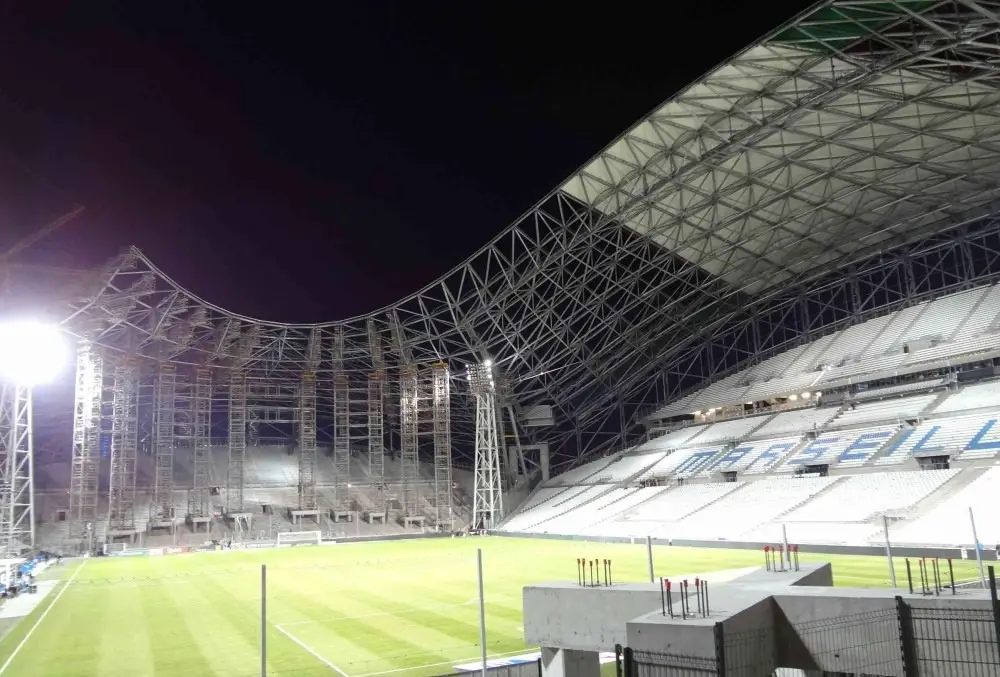French UEFA Euro 2016 Stadiums, Football Buildings Guide, Capacities, Designs, Sports Arenas, Location
French Euro 2016 Stadiums
UEFA Sports Stadia in France – Football Arenas Buildings Guide: Architecture Information
11 + 10 Jun 2016
French UEFA Euro 2016 Stadiums: Buildings Guide
French UEFA Euro 2016 Stadiums: Buildings Guide
This month’s European Championship finals will be the biggest ever, with 51 games staged at 10 locations, including new stadiums in Bordeaux, Lille, Lyon and Nice.
Building the new venues and renovating historic grounds such as Marseille’s Stade Velodrome has cost 1.6bn euros (£1.2bn) – modernisation which was necessary, organisers say, because France did not fully capitalise on hosting the 1998 World Cup.
Stade de Nice – Allianz Riviera Stadium, Nice, southeast France
Design: Wilmotte & Associés
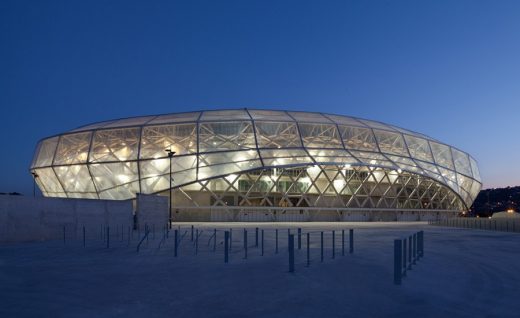
photo © Milène Servelle
Allianz Riviera Stadium in Nice
The Allianz Riviera Stadium is a multipurpose eco-stadium designed by architects Wilmotte & Associés. The architectural parti was transparency, and special attention was paid to the stadium’s skin, eliminating the distinction between inside and outside and animating both the interior and exterior of the building.
Stade de France Building in Paris
Design: Michel Macary, Aymeric Zublena, Michel Regembal, Claude Constantini
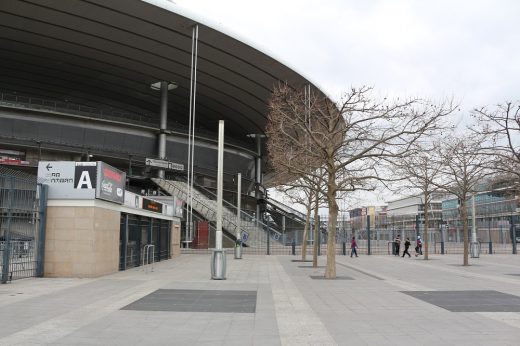
photo by SK Sturm Fan – Own work, CC BY-SA 3.0, http://commons.wikimedia.org/w/index.php?curid=46542247
UEFA Euro 2016 Ffinal Venue
fifth-largest stadium in Europe.
This arena will host some matches at UEFA Euro 2016, including the final.
New Olympique Lyonnais Stadium, Lyon, southern France
Design: Populous
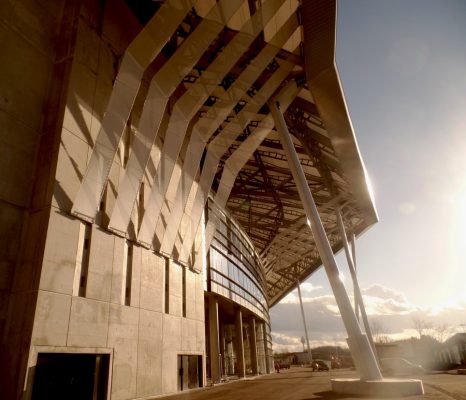
photo from architects
Olympique Lyonnais Stadium in Lyon
The new home of Olympique Lyonnais opened on the 9th January 2016. The Grand Stade de Lyon will become a fantastic new home ground for one of France’s most iconic football teams and provide a key venue for the UEFA Euro 2016 Finals, including the first semi-final on the 6th July.
Stade Vélodrome, Marseille
Architect: Henri Ploquin
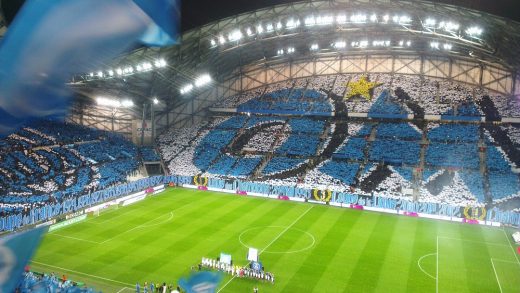
photo by Hombrey – Own work, CC BY-SA 4.0, http://commons.wikimedia.org/w/index.php?curid=39829027
French UEFA Euro 2016 Stadiums
Buildings listed by capacity
– Stade de France
Saint-Denis
Capacity: 81,338
– Stade Vélodrome
Marseille
Capacity: 67,394
– Parc Olympique Lyonnais
Lyon
(upgraded) Capacity: 59,286
– Stade Pierre-Mauroy
Lille
(new stadium) Capacity: 50,186
– Parc des Princes
Paris
(upgraded) Capacity: 48,712
– Matmut Atlantique
Bordeaux
(upgraded) Capacity: 42,115
– Stade Geoffroy-Guichard
Saint-Étienne
(upgraded) Capacity: 41,965
– Allianz Riviera
Nice
Capacity: 35,624
– Stade Bollaert-Delelis
Lens
(upgraded) Capacity: 38,223
– Stadium Municipal
Toulouse
(upgraded) Capacity: 33,150
Olympique Lyonnais Stadium in Lyon – UEFA Euro 2016 first semi-final venue:
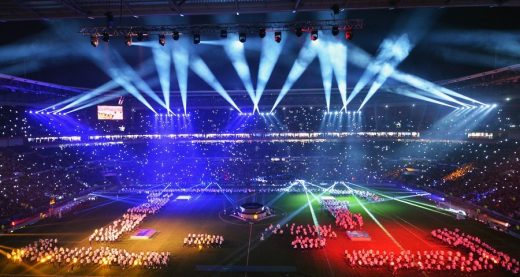
image from architects
French UEFA Euro 2016 Stadium Buildings Guide
Stade de Bordeaux, Bordeaux
Capacity: 42,000
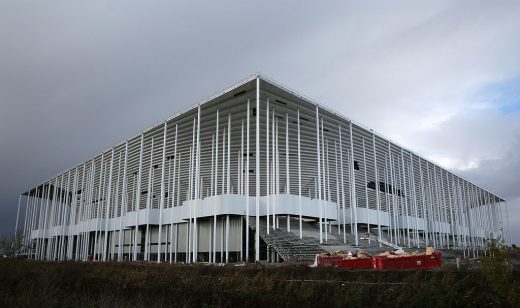
photo by PA, Own work, courtesy wikimedia commons
Created by the architects behind Munich’s Allianz Arena and Beijing’s ‘Bird Nest’ Olympic stadium, the Stade de Bourdeaux has steep stands, with upper tiers at a 35° angle – the maximum allowed in France.
The 184m euro (£130m) stadium’s stanchions are designed to resemble pine trees in the nearby Landes forest.
Bordeaux had previously played at the Stade Chaban-Delmas – a venue at the 1938 and 1998 World Cups.
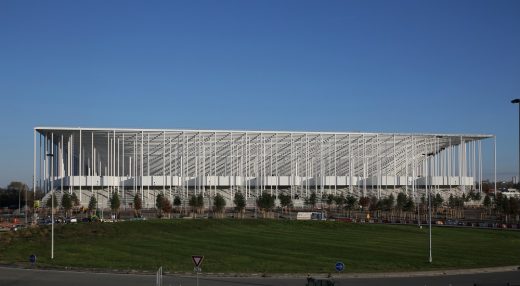
photo by PA, Own work, courtesy wikimedia commons
Bordeaux’s Euro 2016 games
Group B – Wales v Slovakia, 11 June (17:00 BST)
Group F – Austria v Hungary, 14 June (17:00 BST)
Group E – Belgium v Rep. Ireland, 18 June (14:00 BST)
Group D – Croatia v Spain, 21 June (20:00 BST)
Quarter-final #3, 2 July (20:00 BST)
Stade Bollaert-Delelis, Lens
Capacity: 38,000
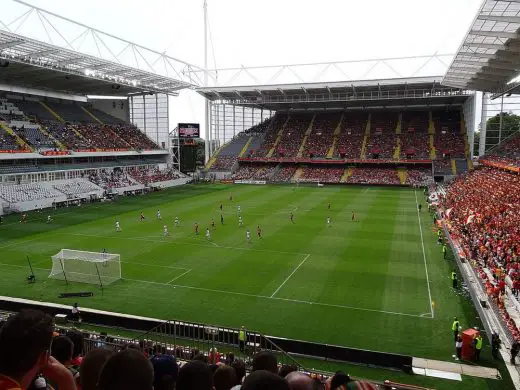
photo by Liondartois, Own work, courtesy wikimedia commons
The Stade Bollaert-Delelis was originally oval but rectangular stands were added in the 1970s – giving it an English-style look.
The scene of Laurent Blanc’s golden goal for France against Paraguay at the 1998 World Cup, it was also used at Euro ’84, but needed a 70m euro (£50m) upgrade for Euro 2016, and was shut for renovation last season.
Lens’ Euro 2016 games
Group A – Albania v Switzerland, 11 June (14:00 BST)
Group B – England v Wales, 16 June (14:00 BST)
Group D – Czech Republic v Turkey, 21 June (20:00 BST)
Last 16 (1st Grp D v 3rd Grp B, E or F), 25 June (20:00 BST)
Stade Pierre Mauroy, Lille
Capacity: 50,000
Named after a former French prime minster and mayor of Lille, the Stade Pierre Mauroy is home to the city’s top-flight club but has also hosted rugby union, basketball and tennis – including the 2014 Davis Cup final.
A clever design feature allows the northern half of the pitch to be raised several metres in the air and slid directly over the southern half.
That reveals a compact ‘showcase’ level with room for temporary seating – ideal for focusing attention on a smaller area such as tennis court or musical stage. The unused half of the stadium is then curtained off to create a better atmosphere.
The stadium’s roof can open or close in 30 minutes, is 31 metres high and was built using 7,400 tonnes of steel.
Lille’s Euro 2016 games
Group C – Germany v Ukraine, 12 June (20:00 BST)
Group B – Russia v Slovakia, 15 June (14:00 BST)
Group A – Switzerland v France, 19 June (20:00 BST)
Group E – Italy v Rep. Ireland, 22 June (20:00 BST)
Last 16 (1st Grp C v 3rd Grp A, B or F), 26 June (17:00 BST)
Quarter-final #2, 1 July (20:00 BST)
Stade de Lyon, Lyon
Capacity: 59,000
Olympique Lyonnais Stadium in Lyon – UEFA Euro 2016 first semi-final venue:
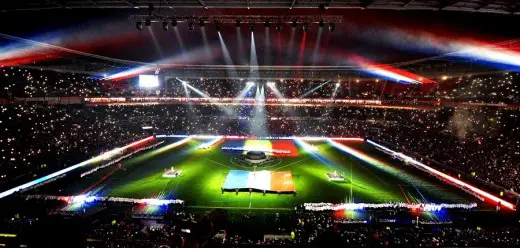
image from architects
A site was chosen for Lyon’s new home in 2007 but legal action from opponents of construction meant building on the Stade de Lyon only began in earnest in 2013. The venue opened on 9 January, when Lyon beat Troyes 4-1.
The stadium is the centrepiece of a 50-hectare complex which includes a new training ground and hotels. Its most distinctive feature is its roof, which overhangs the stadium like a giant umbrella, providing shelter to fans immediately outside.
It is the first major stadium privately owned by a French football club – the rest rent. Inspired by Arsenal’s financial success at Emirates Stadium, Lyon expect the 405m euro (£294m) cost of their home to be returned via higher match-day revenue.
Lyon’s Euro 2016 games
Group E – Belgium v Italy, 13 June (20:00 BST)
Group C – Ukraine v Northern Ireland, 16 June (17:00 BST)
Group A – Romania v Albania, 19 June (20:00 BST)
Group F – Hungary v Portugal, 22 June (17:00 BST)
Last 16 (1st Grp A v 3rd Grp C, D or E), 26 June (14:00 BST)
Semi-final #1, 6 July (20:00 BST)
Stade Velodrome, Marseille
Capacity: 67,000
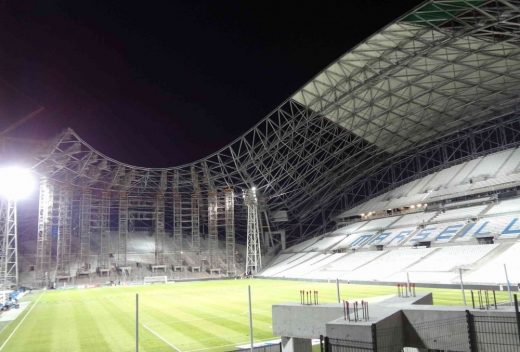
photo by Om13008 – Own work, CC BY-SA 3.0, http://commons.wikimedia.org/w/index.php?curid=26384753
Built for the 1938 World Cup, Marseille’s Stade Velodrome originally featured a cycling track, which was removed in 1985. Capacity was expanded to 67,000 for the 1998 World Cup by adopting distinctive round stands – three of which were uncovered, exposing supporters to the powerful mistral winds that blow in off the Mediterranean.
The new Velodrome’s undulating roof solves that problem while retaining the stadium’s unique look. The end result is impressive – but costly.
As the club did not contribute to the 267m euro (£193m) project, the heavily indebted city council requested a five-fold increase on Marseille’s 1.5m euro annual rent. A compromise was eventually agreed in 2014.
Stade Vélodrome Euro 2016 stadium in Marseille:
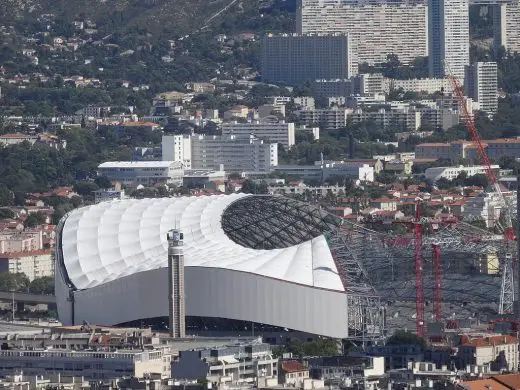
photo by Guiguilacagouille, Own work
Marseille’s Euro 2016 games
Group B – England v Russia, 11 June (20:00 BST)
Group A – France v Albania, 15 June (20:00 BST)
Group F – Iceland v Hungary, 18 June (17:00 BST)
Group C – Ukraine v Poland, 21 June (17:00 BST)
Quarter-final #1, 30 June (20:00 BST)
Semi-final #2, 7 July (20:00 BST)
Stade de Nice, Nice
Capacity: 36,000
Nice had been looking for a replacement for their antiquated stadium – the Stade du Ray – since the turn of the century. Plans for a new ground were abandoned in 2002 and 2006 but Euro 2016 gave the project impetus, and work began in 2011.
Located to the west of Nice, three miles from the city’s airport, the Stade de Nice is a multi-event arena designed to host rugby, tennis, motorsport and concerts as well as football. The stadium also hosts France’s national museum of sport.
Usually known as the Allianz Riviera for sponsorship reasons, during Euro 2016 it will instead simply be the Stade de Nice.
Nice’s Euro 2016 games
Group C – Poland v Northern Ireland, 12 June (17:00 BST)
Group D – Spain v Turkey, 17 June (20:00 BST)
Group E – Sweden v Belgium, 22 June (20:00 BST)
Last 16 (2nd Grp B v 2nd Grp F), 27 June (20:00 BST)
Parc des Princes, Paris
Capacity: 48,000
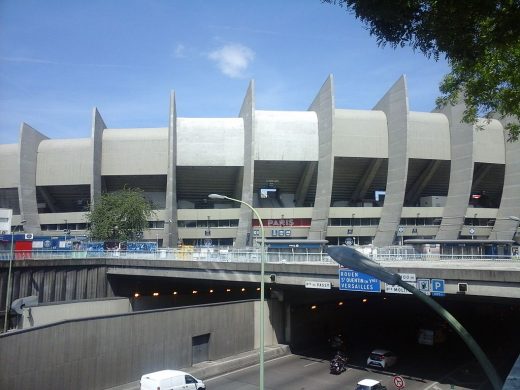
photo by Janick Sallé, Own work, courtesy wikimedia commons
At 48,000 seats, the Parc des Princes may be smaller than the other Euro 2016 venue in the French capital, the Stade de France, but it boasts more history. It staged the first European Cup final in 1956 – won by Real Madrid – and France’s win against Spain in the Euro ’84 final.
Constructed in 1897, it was completely rebuilt in 1932 and again in 1972 – when the cycling track was removed and the stadium redesigned around an underground ring-road. Recently formed Paris St-Germain became tenants in 1974.
PSG’s Qatari owners bankrolled a 75m euro (£54m) facelift prior to Euro 2016 and the club want further expansion to seat 60,000 fans – but the proximity of the ring-road may prove problematic.
Parc des Princes’ Euro 2016 games
Group D – Turkey v Croatia, 12 June (14:00 BST)
Group A – Romania v Switzerland, 15 June (17:00 BST)
Group F – Portugal v Austria, 18 June (20:00 BST)
Group C – Northern Ireland v Germany, 21 June (17:00 BST)
Last 16 (1st Grp B v 3rd Grp A, C or D), 25 June (17:00 BST)
Stade de France, Paris
Capacity: 81,338
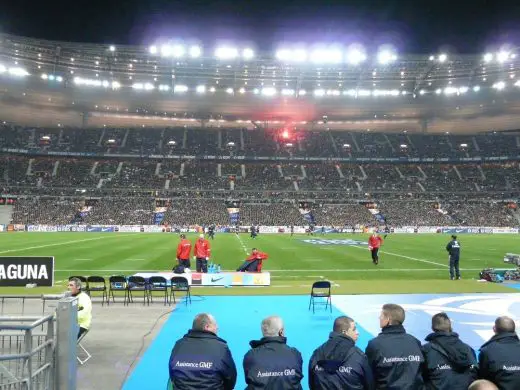
photo by bigup21, CC BY 3.0, http://commons.wikimedia.org/w/index.php?curid=47811241
The Stade de France was the only new stadium built for the 1998 World Cup, at which it hosted nine games – including France’s 3-0 victory over Brazil in the final.
It took over from the Parc des Princes as the home of France’s national football and rugby union sides and has a distinctive elliptical roof, which appears to float above the stadium – despite weighing more than the Eiffel Tower.
It was the venue for November’s friendly international between France and Germany, when three suicide bombers detonated devices outside the stadium.
French sports minister Patrick Kanner praised stadium officials for their calm response to the explosions. Nonetheless, security will be enhanced at the Stade de France and all other Euro 2016 venues as a result of the Paris attacks.
Stade de France’s Euro 2016 games
Group A – France v Romania, 10 June (20:00 BST)
Group E – Rep. of Ireland v Sweden 13 June (17:00 BST)
Group C – Germany v Poland, 16 June (20:00 BST)
Group F – Iceland v Austria, 22 June (17:00 BST)
Last 16 (1st Grp E v 2nd Grp D), 27 June (17:00 BST)
Quarter-final #4, 3 July (20:00 BST)
Final, 10 July (20:00 BST)
Stade Geoffroy Guichard, Saint-Etienne
Saint-Etienne’s Stade Geoffroy Guichard was initially selected only as a reserve venue (along with Toulouse) for Euro 2016 before organisers decided that both were needed to cope with the tournament’s expanded format.
Capacity has increased from 35,600 to 42,000, with seats installed in the four corners, although three of those sections are single-tiered.
Welcome to Green Hell
Saint-Etienne fans are renowned for the atmosphere generated at their home – which has been dubbed “Le Chaudron” (The Cauldron) and “L’enfer Vert” (Green Hell).
The stadium is named after the businessman who purchased the site. It hosted matches at Euro ’84 and the 1998 World Cup – where it staged England’s last-16 exit to Argentina.
Saint-Etienne’s Euro 2016 games
Group F – Portugal v Iceland, 14 June (20:00 BST)
Group D – Czech Republic v Croatia, 17 June (17:00 BST)
Group B – Slovakia v England, 20 June (20:00 BST)
Last 16 (2nd Grp A v 2nd Grp C), 25 June (14:00 BST)
Stadium de Toulouse, Toulouse
Toulouse is France’s fourth biggest city but lies in the country’s rugby heartland. The city’s football side won their only honour – the French Cup – in 1957, but the rugby club boast 19 domestic championships and four European titles, both record hauls.
Mini-Wembley
Built on an island in the river Garonne, the Stadium de Toulouse – sometimes referred to as the Stade Municipal – was built for the 1938 World Cup, and was initially described as “mini-Wembley” because of its resemblance to the London venue.
It was not used at Euro ’84 but was revamped for France ’98, hosting six games – including England’s loss to Romania.
Capacity was cut by 2,000 prior to Euro 2016 in order to meet Uefa requirements for wider seats.
Toulouse’s Euro 2016 games
Group D – Spain v Czech Republic, 13 June (14:00 BST)
Group E – Italy v Sweden, 17 June (14:00 BST)
Group B – Russia v Wales, 20 June (20:00 BST)
Last 16 (1st Group F, 2nd Group E), 26 June (20:00 BST)
Source: BBC
Website: French UEFA Euro 2016 Stadiums: Buildings Guide – BBC
Website: UEFA Euro 2016 Stadiums Guide – stadiumguide.com
Website: France Euro 2016 Stadiums Buildings Guide – wikipedia
Another French stadium building on e-architect:
Jules Ladoumègue Stadium, Paris, France
Design: DFA, Dietmar Feichtinger Architectes
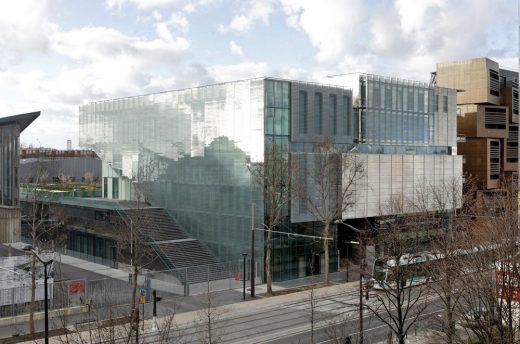
photograph © David Boureau
Jules Ladoumègue Stadium in Paris
Football Stadium Buildings
Léo Lagrange Stadium in Toulon
Design: archi5 studio
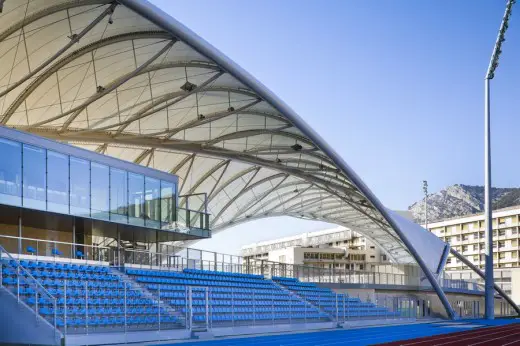
photo : Sergio Grazia
Léo Lagrange Stadium in Toulon
Arena Pantanal Stadium, Cuiabá : 2014 World Cup Venue
Design: GCP Arquitetos
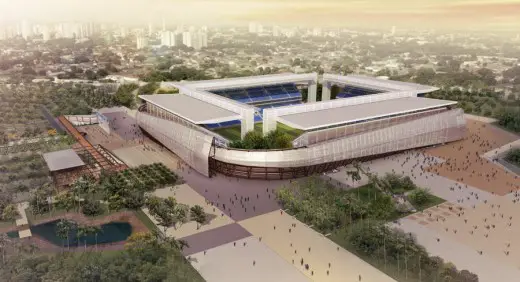
image from architects
2014 World Cup Football Stadium
Amazon Sports Complex Manaus
Design: gmp Architekten von Gerkan, Marg und Partner
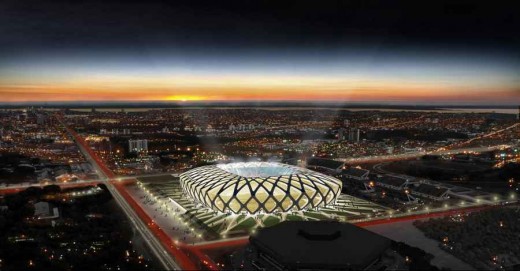
image from architects
World Cup Football Stadium
New Mineirão Stadium, Belo Horizonte
Design: BCMF Arquitetos

photo : Leonardo Finotti
Rostov Stadium, Rostov-on-don, Russia
Populous
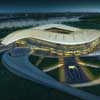
image from architect
Rostov Stadium
Olympic Stadium Kiev, Ukraine
Design: gmp – von Gerkan, Marg & Partners
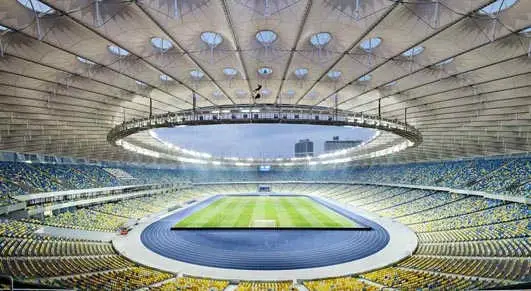
photograph : Marcus Bredt
Kiev Football Stadium
National Stadium Warsaw, Poland – EURO 2012 Venue
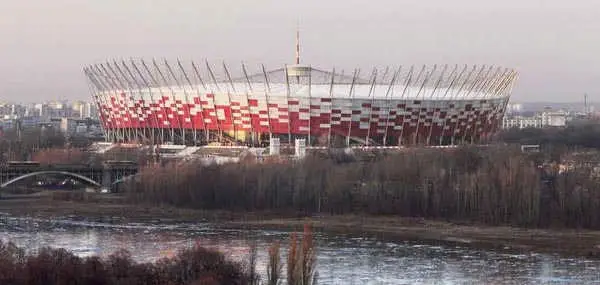
photograph : Marcus Bredt
Warsaw Football Stadium
Warsaw National Stadium, Poland – UEFA EURO 2012 Venue

photo : FCC/Alpine
Football Stadium Poland
Qatar World Cup Football Stadiums
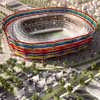
image from architects
World Cup Stadiums – South Africa 2010
Qatar World Cup Football Stadiums
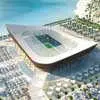
image from architects
FFR Grand Stade, Essone, south west of Paris, France
Design: Populous + Ateliers 2/3/4/
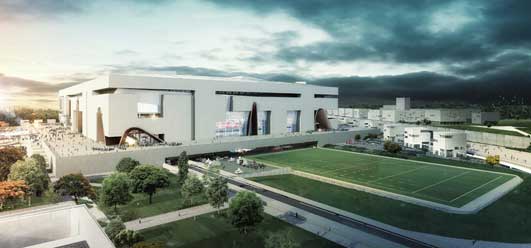
photo from architects
FFR Grand Stade in France
Location: France
New Buildings in France
French Architectural Projects
French Architecture Design – chronological list
French Architect Offices – design firm listings
The Orange Cube
Architects: Jakob + Macfarlane
The Orange Cube Lyon
European Football Stadiums Selection:
One of the greatest football stadiums in Europe: Nou Camp Stadium
Munich Stadium – Allianz Arena
German Football Stadium Building – Frankfurt
Gelsenkirchen Stadium – Arena Auf Schalke
Comments / photos for the French Euro 2016 Stadiums Buildings Guide page welcome

